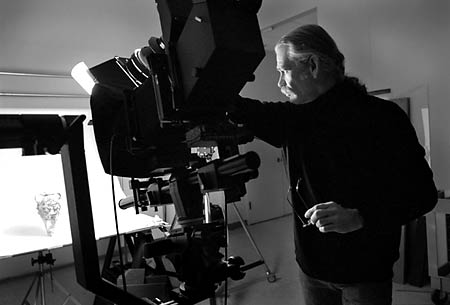The Big Picture
Jay Beebe, Fine art photographer

Photo by Stephanie Mitchell
One day, it’s an ancient jade carving knife, so subtle in its contours that it appears flat until careful lighting restores its shadows and curves.
The next day, Jay Beebe photographs a 4-foot-tall brass statue polished to a blinding gleam; he must build a small foam-core room around it to reduce its glare.
“Every object needs to be dealt with on an individual basis. No two pieces photograph the same,” says Beebe, fine art photographer for Harvard University Art Museums. “You’re constantly challenged to be creative.”
Beebe came to Harvard a year and a half ago to assist with the Museums’ transition from analog photography to digital imaging. In his studio at the Arthur M. Sackler Museum, he photographs between two and five three-dimensional items from the Sackler or Fogg collections each day; his colleagues give two-dimensional art the same treatment next door.
While his workload is dictated by upcoming shows and catalogs, he is also re-shooting archival photographs of artwork whose original film photos are degrading. Longevity is one reason his department is moving all its images to digital; access is another.
“We’re giving a greater audience availability to the collection,” says Beebe, noting that images might go on the Web as a small file, while a large, detailed digital file would provide a scholar with much more detail than the naked eye could see.
Beebe, whose 28-year photography career includes lots of location work for films and commercials, admits that fine art photography is sometimes seen as sterile, yet he’s never bored.
“The challenge is in giving shape and form with light,” he says, “so that it’s interesting and stimulating to look at.” As objects of different shapes, sizes, materials and conditions parade through his studio, he’s constantly adjusting lighting, working closely with curators to showcase the items’ unique qualities.
“The wonderful thing about being here is the collections. They’re incredible,” says Beebe. Yet like the parent who loves all his children equally, he declines to name a favorite work. “There’s very little that I’ve seen that I haven’t been fascinated with in one way or another.”




